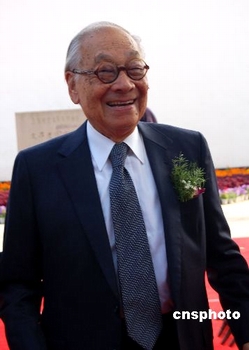| |||||||||||||||||||||||||||||||||||||||||||||||||||||||||||||||||||||||||||||||||||||||||||||||||||||||||||||||||||||||||||||||||||||||||||||||||||||||||||||||||||||||
|
Mr. Pei toiled10 over design concepts that might blend East and West while avoiding some of the failures of the Fragrant Hills project, which was also a mix. He sought to remain true to China’s tradition of courtyards and gardens yet rethink those models. He wanted neither a flat Western roof nor the arched gray tile roof typical of Suzhou.
He found a solution that incorporated the idea of whitewashed11 walls but eliminated the gray tile roofs, accenting the building instead with gray stone.
“Instead of gray tile roofs, I needed something that would develop volumes,” he said, drawing a diagram on a paper showing an ascending12 roof pattern. “So I let the walls climb onto the roof. If the walls were stucco, why not the roof?”
The result is a 160,000-square-foot museum that has many of the hallmarks of Mr. Pei’s earlier designs — his squares, rectangles and pyramids — as well as an expansive use of glass and light. It also has traditional motifs13, like a large Chinese garden with an artificial pond, a Chinese footbridge and a wall of thinly sliced rocks that yields an image of a series of mountain peaks against an older, whitewashed garden wall.
The timing14 of the opening was ideal, coinciding with the Mid-Autumn Festival, when the Chinese return home to pay homage15 to their ancestors and to snack on “moon cakes.” To celebrate the opening Mr. Pei invited more than 100 relatives and close friends from around the world, including friends from the art and music worlds. On Friday evening the Suzhou government gave a party for Mr. Pei with a show of traditional Chinese art and music, and on Saturday Mr. Pei held his own private party, a night of music, dance and fireworks.
Suzhou was a major cultural center during the Ming and Qing dynasties, and the museum houses relics16 from those periods, including jade17, porcelain18, calligraphy19 and paintings. Also on view is a special exhibition of works by three contemporary artists, Xu Bing, Cai Guoqiang and Zhao Wuji, all of whom left China to study or create away from home, just as Mr. Pei did.
Since he left his architectural practice in 1990, Mr. Pei said, he has accepted only commissions outside the United States, largely because of his experience in designing the addition to the Louvre in Paris, with its famed glass pyramid. “That project taught me that to know a country you have to work there on a project of consequence,” he said. “So after that project I told myself, ‘Let’s learn about the world.’ ”
With his Suzhou Museum design, Mr. Pei said, he hopes to encourage and even inspire China, which is in the midst of a frantic20 building boom, to consider its own rich traditions, to be neither a slave to the past nor an weak imitator of the West.
Looking out from the 48th-floor lounge in the Shangri-La Hotel toward a series of huge real estate projects — row after row of what might be considered Chinese versions of Levittown — Mr. Pei said: “Terrible things are happening. I can’t stop it. I can’t stop progress. But I hope it will be temporary.”
He said he hoped that in time the country would find its own path.
In China, “architecture and the garden are one,” he said. “A Western building is a building, and a garden is a garden. They’re related in spirit. But they are one in China.”
As for whether the museum is his final project, Mr. Pei said: “Never predict the future. If you ask my wife, she’ll say that’s it. But if you ask me, I’m not sure it’s the end. There are always challenges in life.”
点击  收听单词发音 收听单词发音
|
|||||||||||||||||||||||||||||||||||||||||||||||||||||||||||||||||||||||||||||||||||||||||||||||||||||||||||||||||||||||||||||||||||||||||||||||||||||||||||||||||||||||
- 发表评论
-
- 最新评论 进入详细评论页>>




